Gamefound Tabletop Alert: Journey Through the ‘Lands of Galzyr’

Embark on an epic adventure in the world of Daimyria, seeking out quests to earn prestige.
What Is Lands of Galzyr?
Lands of Galzyr is a game for 1 to 4 players, ages 14 and up, and takes about 60 to 150 minutes to play. It’s currently seeking funding on Gamefound, with a pledge level of €69.95 (about $83USD) for a copy of the base game, or €129.95 (about $153USD) for the deluxe edition. Although it’s marked as 14 and up, I played with my 8-year-old as well; there’s a lot of reading aloud involved but at least the storylines we explored weren’t inappropriate for kids. The game takes place in the same world as Dale of Merchants, but the gameplay is entirely different and you don’t need to know anything about Dale of Merchants to play it.
Lands of Galzyr was designed by Sami Laakso and Seppo Kuukasjärvi and is published by Snowdale Design, with illustrations by Sami Laakso and Jesús Delgado.
New to Gamefound? Check out our crowdfunding primer.

Lands of Galzyr Components
Note: My review is based on a prototype copy, so it is subject to change and may not reflect final component quality. It did not include all of the cards and was missing the quest tokens. The deluxe edition will not add any new gameplay elements, but gives you some premium components like extra dice and card sleeves, a dice tray, a playmat, plus an adventure journal and a soundtrack.
Here’s what will come in the game:
- Game board
- 4 Adventurer meeples
- 4 Adventurer boards
- 4 Prestige tokens
- 48 Skill pegs
- 18 Dice (17 custom 6-sided dice, 1 standard 12-sided die)
- 480 Cards
- 3 Organization trays
- 14 Card Dividers
- 44 Timer tokens
- 6 Quest tokens
- Day token
- Starting Player token
- Souvenir token
- Travel Guide

The game board is a map of Galzyr, showing various cities and the paths connecting them, along with various spaces marked along the paths as grasslands, forests, hills, and so on. The cities themselves have cards with matching artwork that slot into the spaces, adding specific locations like marketplaces, museums, and docks. Along the top of the board is a prestige track for keeping score, and at the bottom is a “calendar” used for tracking the days (and upcoming events). The board is double-sided, with a winter side and a summer side; each of the city cards is also double-sided so the artwork matches.
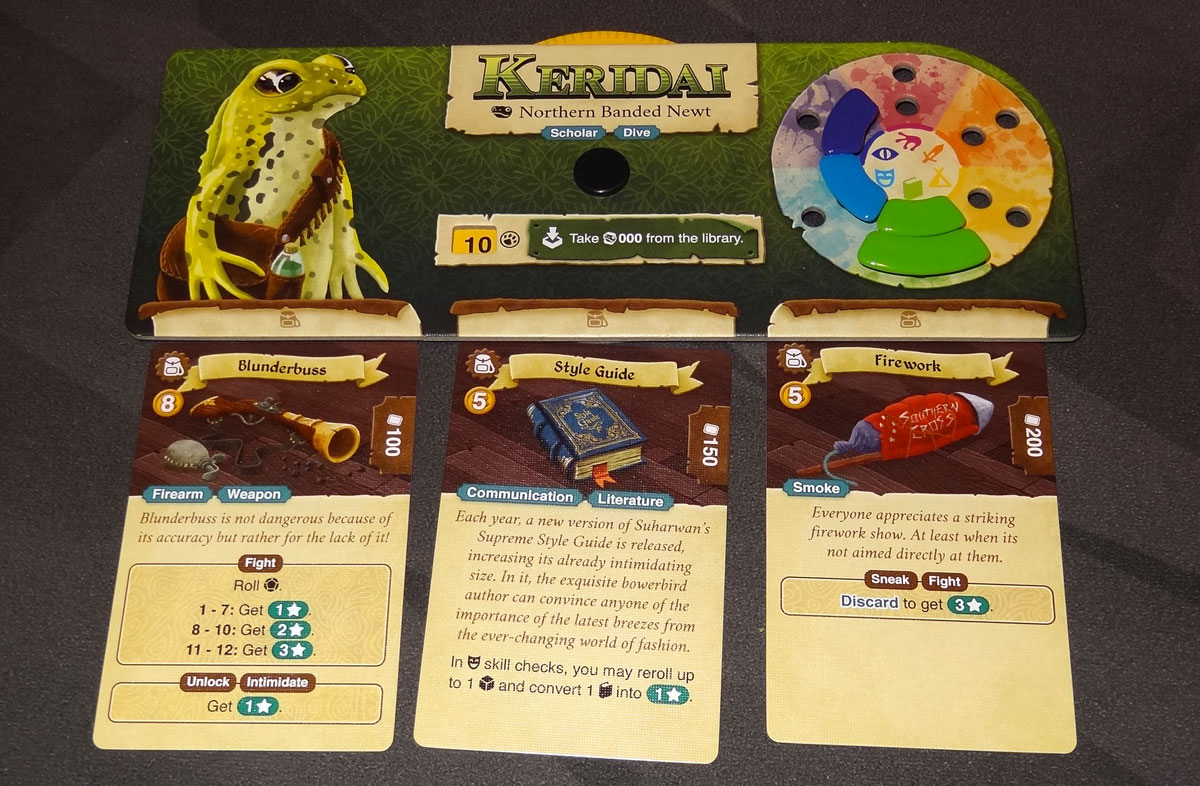
Each adventurer has a board that tracks their gold with a spinner dial, along with their skill points. The spinner was a little loose in the prototype, which was generally fine for playing the game, but you also save the amount of gold between games, and I worry that it would be easy to bump that when putting the board away and getting it back out. The rainbow-colored wheel on the right shows the six skills used in the game; at any given time, an adventurer has four skills, marked by plastic pegs that plug into the board. It’s a fun way to visualize what skills you have, but I’m not totally convinced it’s the best solution—if you push the board down on the table, it’s possible to pop the pegs out (though since they’re colored, you won’t get them mixed up). It may have been just as easy to use wooden cubes or something generic, but these do add a nice pop of color (that also matches the dice). Each adventurer board also has two “tags” below the name—these can come into play during the game, just like the tags present on the items or other cards you may acquire.

The dice are custom six-sided dice. The black dice are the base skill dice, with one of each icon on the six faces. The advanced skill dice are colored to match the skills, and each of those has two faces with double icons for the respective skill, along with two sides for each of the adjacent skills. For instance, the purple die is for Perception (eyes) and has two faces with double eyes; the adjacent skills are Communication (happy mask) and Thievery (hand), so the die also has two faces for each of those—but it does not include any of the other three skills.

The meeples are cute: they’re custom shapes with an additional single color painted on them, to match the character portraits.

The timer tokens will look familiar to those who have played Dale of Merchants, because they feature the same animal icons used in that game. These small tokens come in pairs: one is placed on the calendar, and the other is placed on a card that has a timed effect. When the day token reaches a timer token on the calendar, that triggers the card effect. I don’t know how likely it is that you’ll need all 22 pairs in play at the same time, but it’s fun to have a lot to choose from.
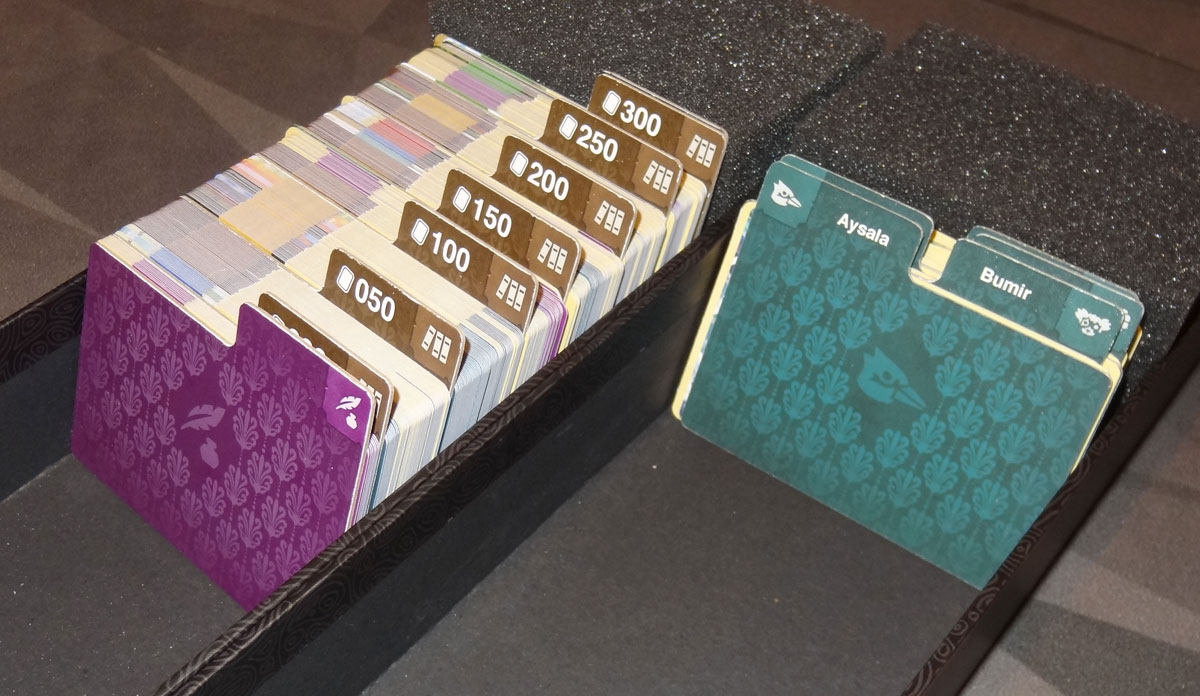
The game includes two card trays—one holds the “library,” the bulk of the cards, which are sorted in order and marked with dividers; the other is for saving the game, with one divider per character, as well as a global section that stores things like the city cards, current global effects, and the quests that were on the noticeboard. The prototype didn’t include all of the cards, so everything actually fit into one card tray, but presumably the trays will be a bit fuller in the finished version. Each of the cards has a three-digit number on the right edge, so that when they’re placed horizontally in the trays you can flip through them easily without reading the actual card contents. (And, of course, you should avoid doing that because of potential spoilers.)
I’ll have more to say about the cards later, but each one has a bit of artwork at the top, a few tags that are keywords referred to by various skill checks or story choices, and then a description of what the card does. Some cards share the same number: for instance, all of the 150 cards are books, so sometimes you’ll be instructed to take a random 150 and you just grab any card with that number. Many numbers are unique, and some even have a character icon on them to indicate that they’re specifically for that character.

The game even includes a travel guide, made to look like an artifact from within the world. It’s a tri-fold pamphlet on thick cardstock, with details about each of the cities and a little bit about Galzyr in general. It’s a fun way to help immerse you in the story, but isn’t required for gameplay.
Overall, the components were quite nice, even in the prototype, and I can tell this will be a beautiful game. The weirdest thing to me was the “souvenir token,” which (at least in the prototype) is just a paler copy of the first player token. I’m not sure if it will be something different in the finished game, but it appears to be a cardboard token with no actual use. The prototype did not include the quest tokens, which will be wooden tokens that you use on the board to mark the locations of various quests. (We used timer tokens for the prototype.)
How to Play Lands of Galzyr
You can download a draft of the rulebook here.
The Goal
Lands of Galzyr can be played cooperatively or competitively; in either case, the goal is to score as much prestige as you can, either to reach a threshold collectively or to be the first to reach the goal. The game is played over a series of sessions, with a “save game” function between games.

Setup
Before your first play, there are some instructions for the first setup: after sorting the cards, some cards are placed into various other sections of the box—the “vault” at the back holds some cards that aren’t yet available to be used, and the quest section at the front holds the available quests. The first time you play, you’ll roll the 12-sided die to see what month it is when you begin. You choose 3 quests to place below the game board as the “noticeboard,” marking their locations on the map. You’ll also choose whether to play competitively or cooperatively, placing that card below the game board. Nearby you’ll also have the dice and the shuffled event deck.
The app will determine what “day” it is when you begin, and you place the day token on that day. If there are any timed events (for instance, the cooperative game lasts a number of days based on the player count) then you mark those with timer tokens.
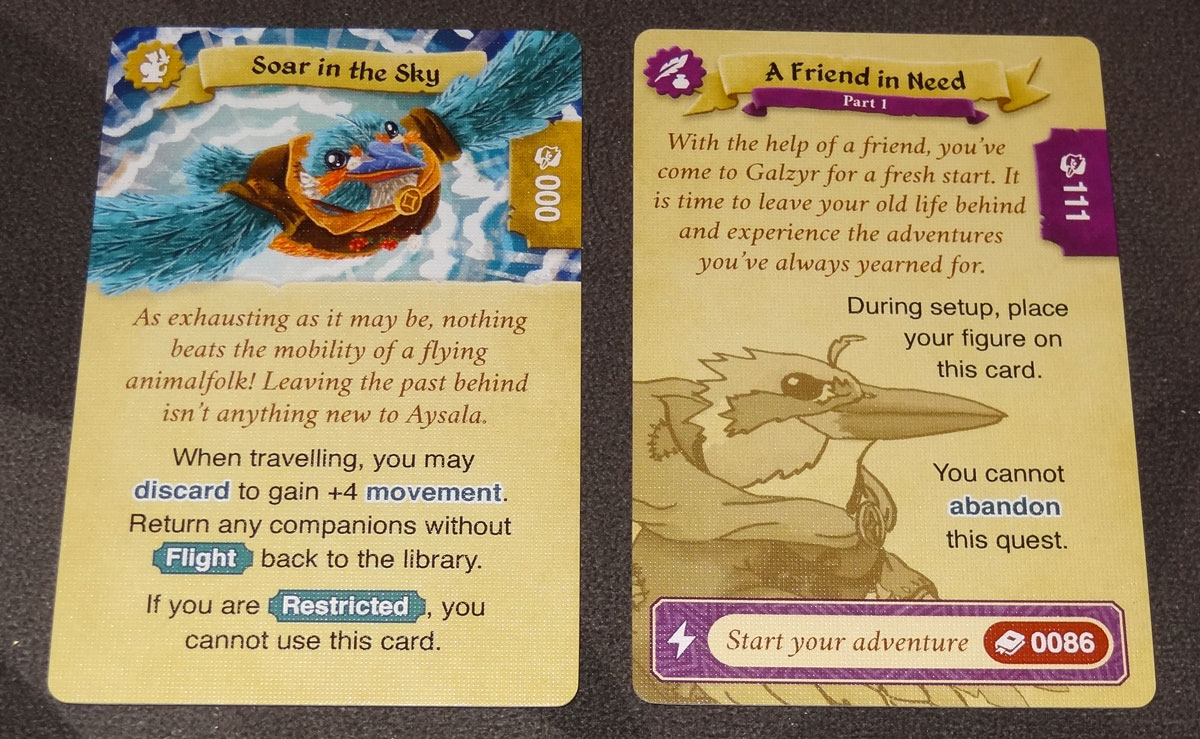
In the first game, each adventurer has a starting set of four skills, 10 gold, and a starting quest and ability. You’ll keep the ability, which can be used once per game, but your skills, gold, quests, and items will carry over from game to game. Aysala the kingfisher, for instance, has a “Soar in the Sky” ability that allows her to move further (but leaves behind any companions that can’t fly), and her starting quest is “A Friend in Need.” Each player chooses a starting location on the board, though in the first game you’ll place your character on your starting quest card.
Gameplay
On your turn, you may move up to two spaces, and then you must resolve a scene. Scenes are indicated by a book and a red number, and you’ll find them on quest cards, on the various city locations, or sometimes on characters or other cards that you may have. If you don’t do any of those (or choose not to), then you get a scene from an event card.
Generally, the player to your right acts as the “story master” for your turn. The game uses a web-based app for the narrative part of the game, with bits of story to read aloud, choices to make, and skill checks to attempt. You give the story master the scene number you’re resolving and they punch in the number and read the story to you. Some scenes—most quests, for instance—will require you to be in a particular location or to fulfill a specific requirement before you can resolve them.

For event cards, the story master draws the top card and checks the list of criteria from top to bottom, choosing the first scene that applies.
After reading the story portion, you’ll get some choices. Sometimes it’s just a narrative choice: do you want to go investigate these noises you hear, or ignore them? Clicking the choice will reveal some more story or offer you other options.
At other times, you’ll be presented with a choice that requires something more—passing a skill check, or spending some money. Or you may be asked whether you have a specific tag: if you have a card with the “First Aid” tag then you may get an additional option in the narrative.

Skill checks will use one of the six skills: Perception, Thievery, Might, Survival, Knowledge, and Communication. They’re also rated easy, medium, or hard, requiring 1, 2, or 3 successes. After selecting an option, you collect the dice you’ll use: you always roll 5 dice (unless you have some status that changes that), but you can replace the base dice with advanced dice based on your skills. For instance, if you’re doing a perception check, you would want to use purple dice, as well as the adjacent pink and blue dice, if you have the right skills for those, since those all have higher chances of rolling the eye icon than the base dice.
You roll all the dice, and then you may optionally re-roll all of the dice once. Count up the number of the relevant icon, and the story master selects that in the app to find out your results. In some cases, the app will also show an icon for a different skill, which opens up an alternate path. For instance, you might be doing a might check, but it asks if there were any eyes rolled—that would mean you spotted something during the task that may make it easier (or allow you to use a different skill instead). You may also use applicable items during your skill checks—if you have any tags that match the verb in a choice, those are also applicable. For instance, the choice above is “Observe the folks at the market” so if you have an item that has an “Observe” tag, then that can be used in this check.
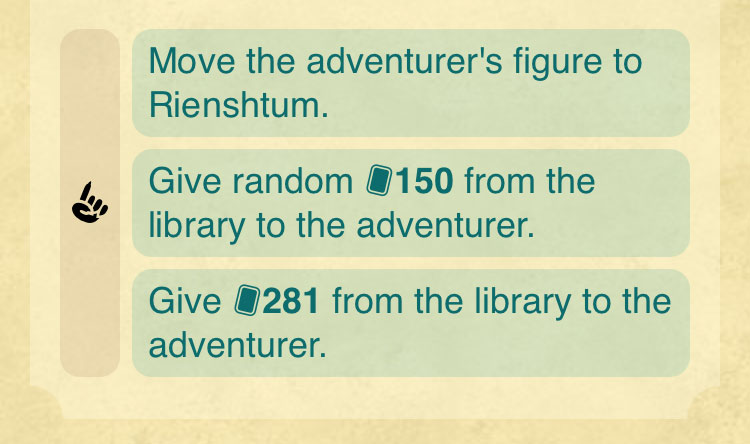
After choices are made or skill checks are passed (or failed), the story master may get some instructions in turquoise. Sometimes cards are returned to the library, you may gain money or prestige, or you may get new cards. Each character may have up to three items stored below their board—any others are returned to the box.

There are other cards you may gain during the course of the game. Status effects may help or hinder you, depending on what they are. Getting exhausted makes you move more slowly, and also subtracts one success from any “run” actions you do, but it goes away after 4 days. Being determined can give you a free one-time success on any check, but you lose it if you become afraid.

You can also get companions, characters that accompany you for a time and provide their own tags and effects. Mercenaries, for instance, can boost some skills—but they’ll go away unless you spend money to delay their timer tokens on the calendar. Other companions may show up as part of a quest.
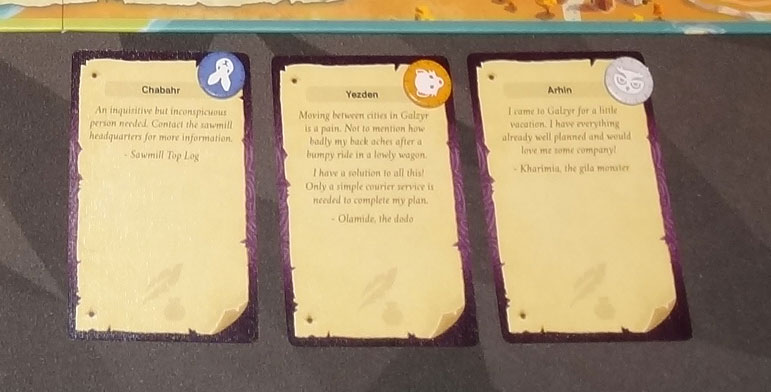
Speaking of quests, the noticeboard is where you’ll find new quests. You each have a starting quest to get you going (and it has multiple parts to complete), but if you’re ever in a location with a quest, you may pick it up for free from the noticeboard. The front side of the quest has a brief description, kind of like a Craigslist posting, but the back has more details including a bit of story and where you need to go or what you need to do to continue the quest. You may have up to three quests in your hand—any others must be abandoned, and there are instructions on the quest card about what to do if you abandon it. (Often, it just gets returned to the noticeboard so somebody else can attempt it, but some quests have other effects when abandoned.) The noticeboard is always refilled back to three quests, as long as there are more cards available in the quest section of the card tray.

After each player has had a turn, advance the day marker, triggering any effects if you reach a timer token.
Game End
When playing competitively, the game ends when somebody reaches the prestige goal (which varies based on player count). When playing cooperatively, the game ends when you reach the set number of days. In either case, you play out the ending scene, which will wrap up the story for that game and potentially have some other effects.
Some cards are automatically discarded at the end of the game, including many of the status effects (so you don’t start a game exhausted); the rest of your cards are placed behind your character divider, and the global effects, the noticeboard, and the event deck are placed in the global save game slot. You retain your gold and skill points for the next time you play!
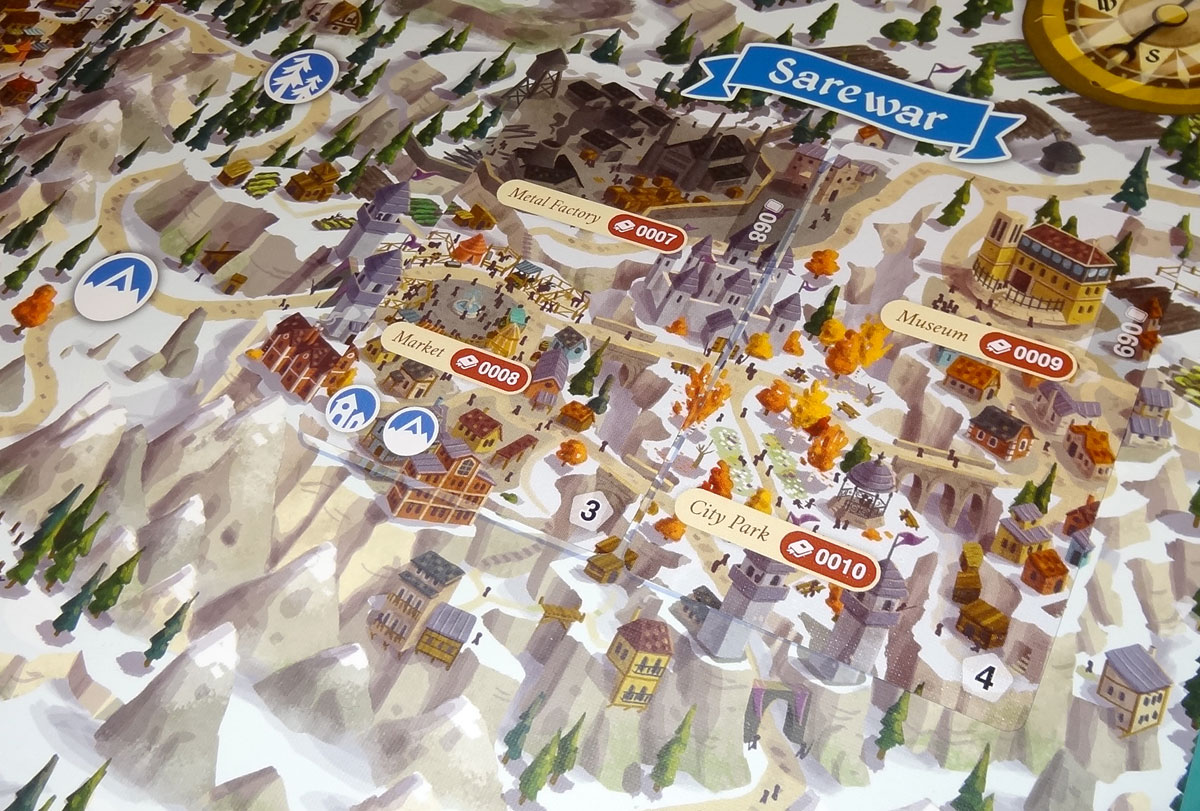
Why You Should Play Lands of Galzyr
I received the prototype after the Gamefound campaign was already running, and only had it for a short while before I needed to send it to another reviewer (it’s in high demand!), but I did get to try out a few plays with my kids, as well as with some of my adult gamer friends.
Not everyone enjoys games that are app-driven. Lands of Galzyr isn’t one where the app is optional, because all of the narrative structure and choices are stored in the digital storybook. I do like that the app is simply a website, so that means it works on any internet-connected device (or you can even save it for offline use) and you don’t need a proprietary app to use it. However, if you’re adamantly against including screens and devices in your tabletop games, then you may not be interested in this one.
I’ve been a fan of the Dale of Merchants series for a while, but that’s not a game that really has a story to it. There’s a thematic setting—the world of Daimyria—filled with talking animals, and the Dale of Merchants Collection includes some character cards that introduce you to some particular characters, but even then the game itself is mostly about the deck-building and not really about character development or following a plot.
Lands of Galzyr puts you in that world and lets you explore it, sending your character from town to town, visiting the marketplace to buy and sell goods, encountering random travelers along the roads, and a wealth of other things. Each of the characters has an initial quest tied to their backstory, and their starting skills reflect those, but I also like the fact that there are many opportunities to change your skills around, too, so you can decide what sort of hero (or villain?) you want to be. The choices you make during the game, like what quests to pursue or which avenues you take to fulfill them, will also shape the story and your character.
There’s still a lot of writing to be done for the game, so in the prototype there were cards with just placeholder text (or sometimes none at all), but the bits that we did read were fun. I will note that there can be a good deal of text and my 8-year-old stumbled a bit on names like Rienshtum and Jaonka, so if you’re not into a game that has a lot of story-reading, you may get impatient. A good portion of the game’s length will be spent reading and listening to stories—the narrative isn’t just flavor text added to the game mechanics, but is a key part of the experience. Even in the bits that I played, there was a wide variety of events and experiences: a missing prince, an investigation into arson at a sawmill, exploring some ancient ruins, crashing a fancy party to steal an artifact.
Some of the missions have multiple parts—when you resolve the first scene, you’ll get a new quest card that gives you further directions, and the story continues to play out. So far the ones I’ve played seem to continue regardless of how you did on the skill check, but it may affect whether you earn prestige or get saddled with negative status effects. But there are some quests that don’t immediately give you another quest: instead, they may add cards from the library into the quest section, so they’ll eventually show up on the noticeboard. Sometimes after resolving an event, the event card goes to the bottom of the deck; other times, the event card is removed and a new event card is added to the deck. So the actions you take may have repercussions that you’ll only discover in a later game, if at all. I love that sort of mystery, the idea of events unfolding outside of your direct perspective, because it helps to create the feel of a larger world that isn’t just static, waiting for you to show up.
The hundreds of numbered cards reminded me of another favorite of mine, 7th Continent, which I’ve been playing with some friends and one of my teens. You don’t have the map exploration, but you do have that sense of discovery from looking up a card number (or a story number), making choices, and sometimes attempting skill checks, to see what happens. In this case, because the game is app-driven, there’s no peeking ahead to see the results of one choice over another, or even the exact success thresholds that may give you better results.

The mechanics of the game mostly boil down to the skill checks. I like the skill wheel and the way that adjacent skills help boost things—if you’re good at survival, that also helps you a little with might and knowledge. The items, companions, and status cards you have will also affect the outcomes of your actions. If you have the spyglass, maybe you’ll be more inclined to take “observe” actions, even if they’re a little harder, because you get an extra success.
It does seem a little strange that when you re-roll dice you have to re-roll all of them—you don’t get to save any successes that you rolled the first time. It makes it a little more random, but there are a lot of items that help you mitigate that luck, either by giving you additional re-rolls of specific dice or guaranteed successes.
My daughters and I played through a bit of the game cooperatively, enough to play out a few of the starting quests and participate in some quests from the noticeboard as well as plenty of the random events from the deck. It was only a small taste of the full game, but it was enough to whet my appetite for more. My youngest daughter (age 8) was particularly taken with the story and the world, and her only complaint about the game was that it’s not finished already so we could explore the whole thing. Some of my adult friends tried it out as well and liked it enough to back it to play together—they have a tradition of playing through legacy games or campaign games during the holidays, and they thought this one would be a fun one to explore.
It’s interesting that Lands of Galzyr can be played both competitively or cooperatively, without really changing much in the mechanics. The main thing is an event card that you place during setup and the resolution at the end—you’ll get different results, but the rest of the gameplay works the same way. There are some events that allow for partners, where you can ask somebody in the same location for help. If they agree, then they contribute their cards and skill points and they may also earn rewards if you’re successful. You may also trade items and money with people in the same location. In a competitive game, players may be less likely to partner up or give each other things, but it’s still allowed. I think I still prefer the cooperative game, simply because each character’s journey can be so unpredictable, and your prestige isn’t always determined by your skill in the game. I like being able to pool our prestige at the end.
I’m definitely looking forward to playing more Lands of Galzyr once it’s finished. If you love story-based games and talking animals, you should check it out. For more information or to make a pledge, visit the Lands of Galzyr Gamefound page!
Click here to see all our tabletop game reviews.
![]() To subscribe to GeekDad’s tabletop gaming coverage, please copy this link and add it to your RSS reader.
To subscribe to GeekDad’s tabletop gaming coverage, please copy this link and add it to your RSS reader.
Disclosure: GeekDad was loaned a prototype of this game for review purposes.
Click through to read all of "Gamefound Tabletop Alert: Journey Through the ‘Lands of Galzyr’" at GeekDad.If you value content from GeekDad, please support us via Patreon or use this link to shop at Amazon. Thanks!

